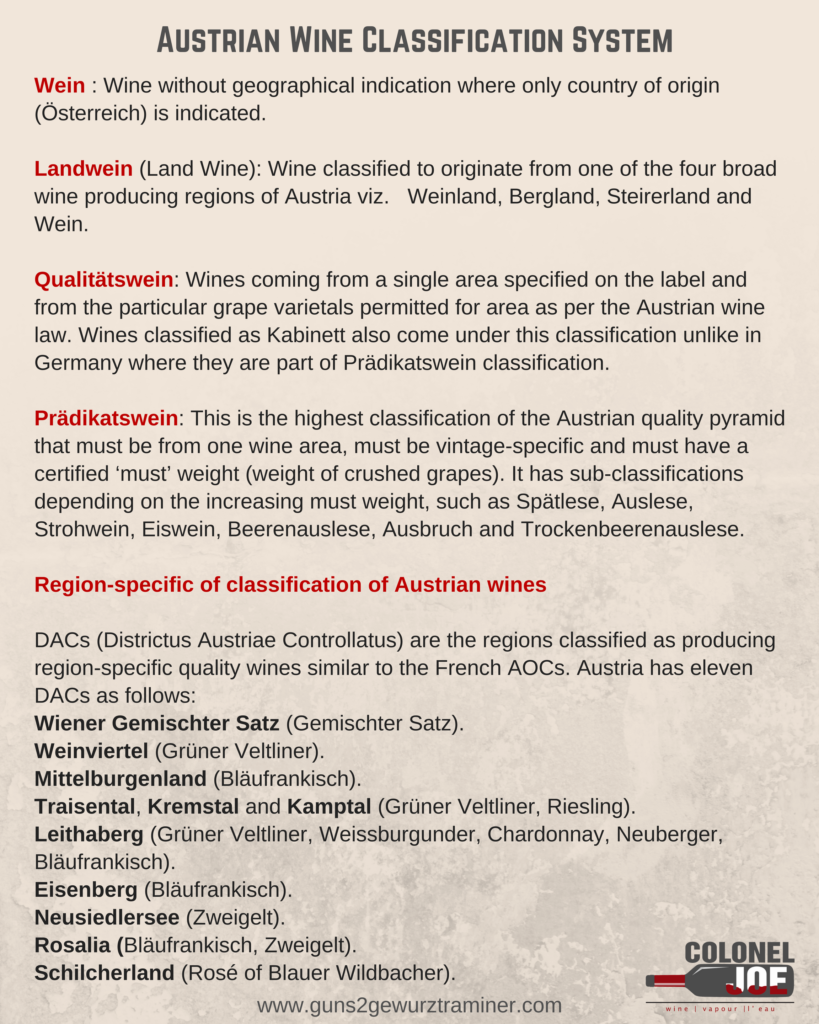Barely a month back as I attended the seminar ‘Austrian Wines- 7 Elements of Uniqueness’ conducted during the Austrian wine fair VieVinum 2016 in Vienna, I asked a question to Willi Klinger, Managing Director Austrian Wine Marketing Board (AWMB) who was chairing the seminar- “when would the much talked about new Austrian Wine Law be formalised?” Willi replied- “anytime now”. Sure enough, even before I could embark on the trip back home, the new law that seeks to make Austrian wine simpler yet more precise, came into effect.
The action on these amendments was going on for sometime, and these reforms finally came into effect on 14 June 2016 in the form of an amendment to the Wine Law of 2009. Among other matters, the amendments encompass modifications to the existing appellatives of wine-growing regions and vineyards.
So what is the fuss all about? To put things in perspective, let us first look at the generic Austrian wine classification in the image below (feel free to download and share):

The New Amendments
The overall essence of the new amendments is to represent various levels of Austrian wine unambiguously and with greater consumer-friendliness. The graphic below covers the salient aspects:

The Details
A Tailwind for the “Rieden”
The demarcation of single vineyard sites, which has been progressing according to the laid out plan in all wine-growing regions, has received new impetus from the amendment to the wine law. It has been determined that wines with a vineyard designation must bear the word “Ried” on the label before the name of the vineyard, i.e. when the word “Ried” appears before a geographic (topographic) designation, it will indicate that the wine has come from a legally defined single vineyard site.
With this provision, wines from single vineyards become recognisable at a glance to the consumer, easily distinguished from branded wines or wines with spurious indications of origin. Growing consciousness about the importance of a clear system for indicating origins has also found expression in the regions Kamptal, Kremstal and Traisental, wherein the DAC wines of these regions have been arranged according to law in a benchmark three-tier system – “Regional-”, “Village-” or “Single Vineyard-” wine. In this structure, classification of the wines must observe a predetermined minimum alcohol content.
Modifications to indications of origin in Burgenland and Steiermark
In order to avoid unnecessary duplication, the Burgenland wine producing appellations Neusiedlersee, Neusiedlersee-Hügelland, Mittelburgenland and Südburgenland have been eliminated. In future, all Qualitätswein from Burgenland will show the generic wine-growing region “Burgenland” on the label.
Only the regionally typical DAC wines shall henceforth be permitted to bear the designation of their specific wine-growing regions – Neusiedlersee DAC, Leithaberg DAC, Mittelburgenland DAC or Eisenberg DAC.
Parallel to this, the Grosslage (large vineyard site) “Südburgenland” is being created to replace the former Grosslagen “Pinkatal” and “Geschriebenstein”.
Pursuant to the amendment, the wine-growing region “Süd-Oststeiermark” in the hilly southeast of Austria shall be renamed “Vulkanland Steiermark” – far more expressive in the conceptual sense.
Ausbruch: exclusively from the Free City of Rust
Special attention has been paid to the Austrian Prädikat wines, particularly the Ausbruch. With the changes to the wine law coming into effect, the term “Ausbruch” is defined as a Trockenbeerenauslese – and as an exclusive, protected indication of origin for Ruster Ausbruch – thus reserved for Trockenbeerenauslesen from Rust. No other wines may henceforth bear the designation “Ausbruch”.
Austrian Sekt with Protected Designation of Origin
In a process of discussions taking place over the course of several years, the Austrian Sekt Committee – together with a committee of growers conducting their own tirage, in concert with experts of the Winegrower’s Association, the Chamber of Commerce, the Austrian Wine Marketing Board and the Federal Agricultural Ministry – have developed new regulations with the goal of enhancing the position of Austrian Sekt with Protected Designation of Origin (Sekt g.U.). Building upon this, the amendment to the wine law now provides that the Minister for Agriculture and Forestry, Water and the Environment is empowered to determine and specify all details pertaining to Sekt with Protected Designation of Origin by means of an ordinance to be filed under seal at a future date.
This ministerial decree will – among other things – stipulate that Austrian Sekt with Protected Designation of Origin can be sold only when bearing the defining terms “Klassik”, “Reserve”, or “Grosse Reserve”. Hereby the sales description must be composed of the category (Österreichischer Qualitätsschaumwein or Sekt), the name of the protected designation of origin (in the cases of Klassik and Reserve, solely the name of the Austrian federal state; in the case of Grosse Reserve: federal state and municipality or part of it; in special cases also Grosslage or Ried) and the term “geschützte Ursprungsbezeichnung” (Protected Designation of Origin) or “g.U.”. Furthermore, the regulations and the conditions applying to its enactment will also establish standards with regard to methods of vinification and interval of élevage on the lees, as well as alcohol content and residual sugar content for the individual tiers.
Austrian wine: Full Speed Ahead
According to the AWMB, standstill is a step backwards. Hence the Austrian authorities are currently working relentlessly to fine tune the unique and distinctive profile of Austrian wine. The evolution of wine laws is considered by them as a pre-requisite towards a successful future for Austrian wine. The latest amendments promise to be a step towards that direction.
With excerpts from a Press Release by the Austrian Wine Marketing Board.










